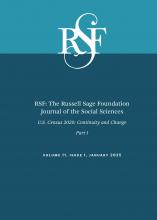Abstract
Population and housing growth are closely linked in the U.S. Census, less so in analysis. Overlooked changes in cohort size and lagged measurements have misled about current housing preferences, and quantity of housing needed, with mistiming producing great volatility. Drawing on decennial census data and American Community Surveys, we develop a cohort-based housing lifecycle model measuring active household formation of renters and owners in intervals from 1990 to 2021. Restrictions of credit and supply legislated in 2010 were aimed at curbing the excesses of the early 2000s bubble but clashed after 2011 with requirements of much larger millennial cohorts, creating shortages in rentals, then ownership. Cohort advancement through the housing lifecycle was greatly delayed until after 2016, when substantial catch-up began of postponed homeownership, widely varied by race. Housing policy should anticipate housing needs of changing cohort sizes and expected life-course transitions, reducing long lags between supply and demand.
- © 2025 Russell Sage Foundation. Myers, Dowell, Hyojung Lee, and JungHo Park. 2025. “Misalignment of Housing Growth and Population Trends: Cohort Size and Lagging Measurements Through Recession and Recovery.” RSF: The Russell Sage Foundation Journal of the Social Sciences 11(1): 86–109. https://doi.org/10.7758/RSF.2025.11.1.05. Direct correspondence to: Dowell Myers, at dowell{at}usc.edu, Sol Price School of Public Policy, University of Southern California, 650 Childs Way, Los Angeles, CA 90089-0626, United States; Hyojung Lee, at hyojung.lee{at}snu.ac.kr; JungHo Park, at jhpark.planner{at}khu.ac.kr.
Open Access Policy: RSF: The Russell Sage Foundation Journal of the Social Sciences is an open access journal. This article is published under a Creative Commons Attribution-NonCommercial-NoDerivs 3.0 Unported License.






